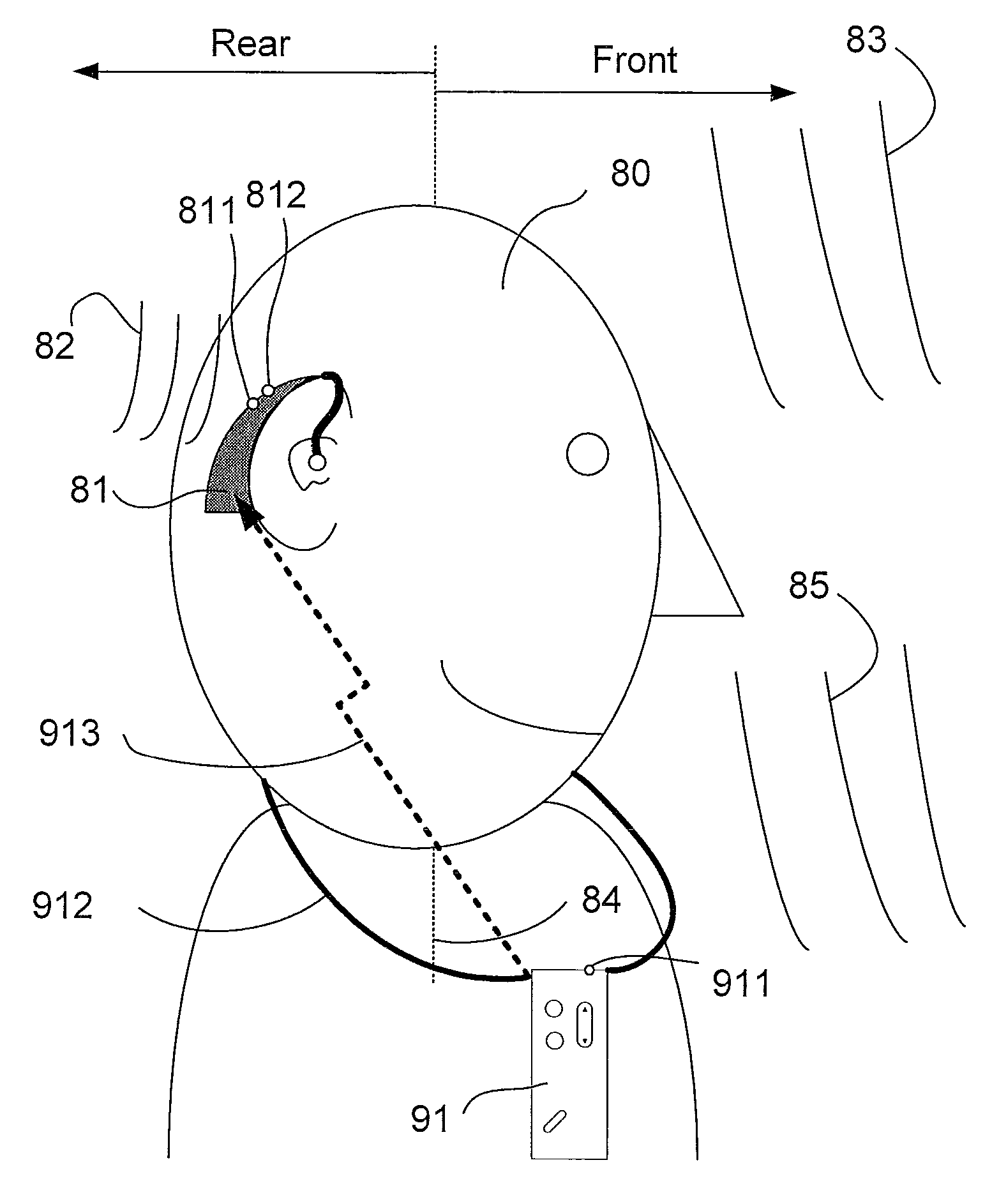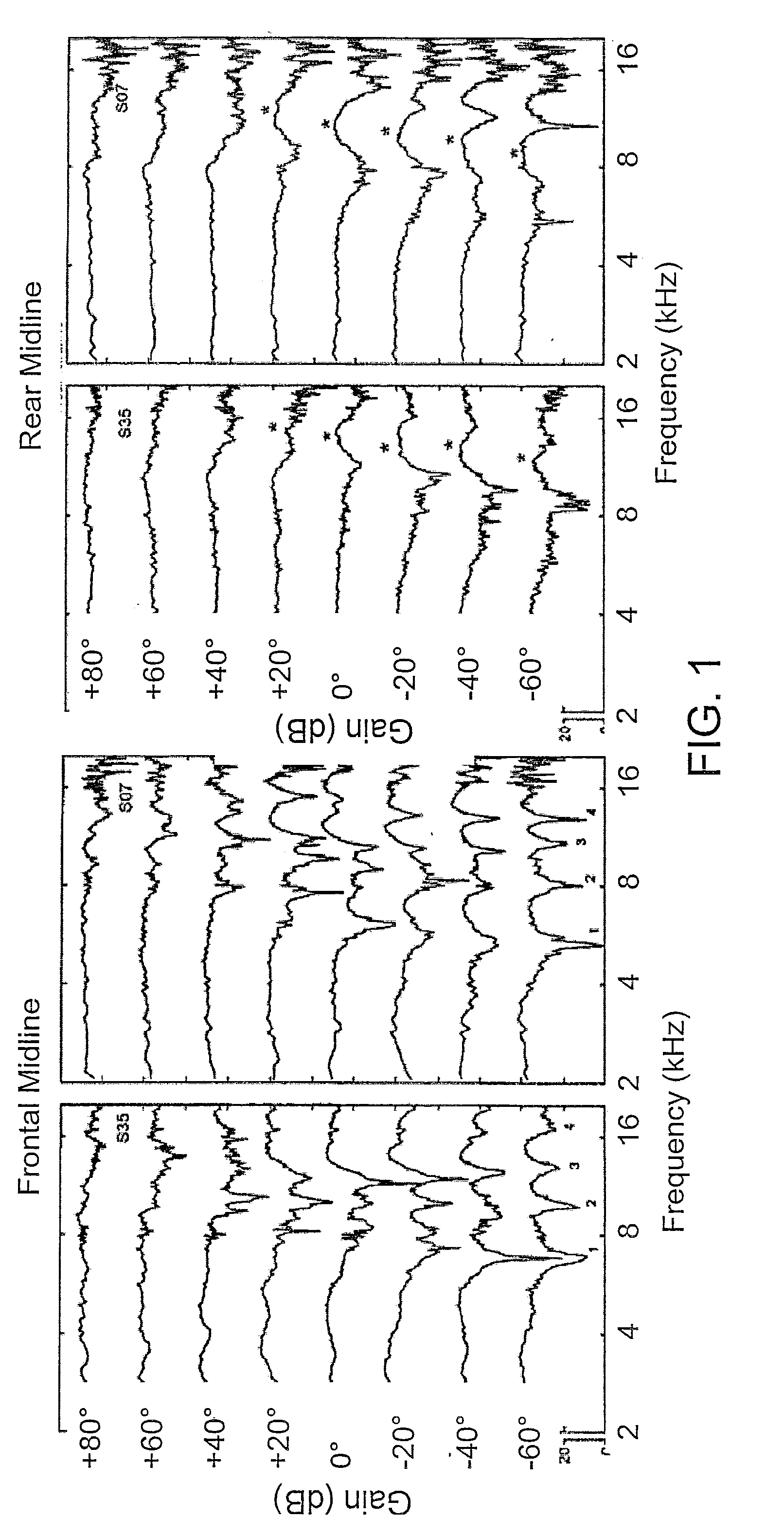[0010]However, it might be possible to introduce localization cues for the hearing impaired, such as frequency-dependent attenuation or direction-dependent peaks or notches. When comparing the spectrally decomposed front and rear cardioids (see e.g. FIG. 2), good front-rear
estimation is obtained. Such a binary front-rear decision can be used to enhance front-rear localization, by applying different
frequency shaping to the sound
signal depending on whether the signal impinges from the front or the rear.
[0014]This has the
advantage of providing an alternative or an addition to natural localization cues.
[0035]In an embodiment, the directional cues (e.g. a number Z of notches located at different frequencies, fN1, fN2, fNz) are modeled and applied at relatively lower frequencies than the naturally occurring frequencies. In an embodiment, the notches inserted at relatively lower frequencies have the same frequency spacing as the original ones. In an embodiment, the notches inserted at relatively lower frequencies have a compressed frequency spacing. This has the
advantage of allowing a user to perceive the cues, even while having a hearing impairment at the frequencies of the directional cues. In an embodiment, the directional cues are increased in magnitude (compared to their natural values). In an embodiment, the magnitude of a notch is in the range from 3 dB to 30 dB, e.g. 3 dB to 5 dB or 10 dB to 30 dB.
[0038]In an embodiment, the FS-unit is adapted to provide that different
frequency shaping is applied to the combined
microphone signal based on a (binary or non-binary) decision of whether a particular instance in time and frequency (a TF-bin or unit) has its origin from a particular direction, e.g. the front of the back of the user. This has the advantage of restoring or enhancing the natural front-back cues. In an embodiment, the FS-unit is adapted to implement a decision
algorithm for deciding whether or not (or with which probability or weight) a given TF-range or unit is associated with a given
spatial direction. In an embodiment, the decision
algorithm (for each TF-range or unit) is |CF|−|CR|≧τ, in a logarithmic expression, where |CF| and |CR| are the magnitudes of the front and rear directional signals, respectively, and τ is a (directional) bias constant. The
algorithm can e.g. be interpreted in a binary fashion to indicate that the signal component of that TF-range or unit is assumed to originate from a FRONT direction, if the expression is TRUE, and the signal is assumed to originate from a REAR direction, if the expression is FALSE. Alternatively, a continuous interpretation can be applied, e.g. in that the (possibly normalized) value of the expression |CF|−|CR|−τ is used as a measure of the probability or weight with which the TF-range or unit in question belongs to a given
spatial direction (positive values indicating FRONT and negative values indicating REAR).
[0047]In an embodiment, the listening device comprises an electrical interface to another device allowing reception (or interchange) of data (e.g. directional cues) from the other device via a wired connection. The listening device may, however, in a preferred embodiment comprise a
wireless interface adapted for allowing a
wireless link to be established to another device, e.g. to a device comprising a microphone contributing to the localization of audio signals (e.g. a microphone of the microphone system). In an embodiment, the other device is a physically separate device (from the listening device, e.g. another body-worn device). In an embodiment, the microphone signal from the other device (or a part thereof, e.g. one or more selected frequency ranges or bands or a signal related to localization cues derived from the microphone signal in question) is transmitted to the listening device via a wired or
wireless connection. In an embodiment, the other device is the opposite hearing instrument of a binaural fitting. In an embodiment, the other device is an audio selection device adapted to receive a number of audio signals and to transmit one of them to the listening device in question. In an embodiment, localization cues derived from a microphone of another device is transmitted to the listening device via an intermediate device, e.g. an audio selection device. In an embodiment, a listening device is able to distinguish between 4 spatially different directions, e.g. FRONT, REAR, LEFT and RIGHT. Alternatively, a
directional microphone system comprising more than two microphones, e.g. 3 or 4 or more microphones can be used to generate more than 2
directional microphone signals. This has the advantage that the space around a wearer of the listening device can be divided into e.g. 4 quadrants, allowing different directional cues to be applied indicating signals originating from e.g. LEFT, REAR, RIGHT directions relative to a user, which greatly enhances the orientation ability of a wearer relative to acoustic sources. In an embodiment, the applied directional cues comprise peaks or notches or combinations of peaks and notches, e.g. of different frequency, and / or magnitude, and / or width to indicate the different directions.
[0049]A listening system comprising a pair of listening devices as described above, in the detailed description of ‘mode(s) for carrying out the invention’ and in the claims is furthermore provided. In an embodiment, the listening system comprises a pair of
hearing instruments adapted for aiding in compensating a persons hearing impairment on both ears. In an embodiment, the two listening devices are adapted to be able to exchange data (including microphone signals or parts thereof, e.g. one or more selected frequency ranges thereof), preferably via a wireless connection, e.g. via a third, intermediate, device, such as an audio selection device. This has the advantage that location related information (localization or directional cues) can be better extracted (due to the
spatial difference of the input signals picked up by the two listening devices).A Method:
 Login to View More
Login to View More  Login to View More
Login to View More 


